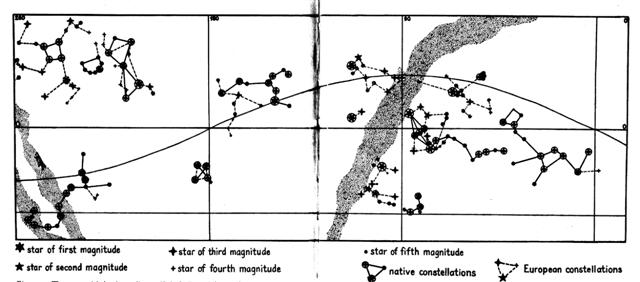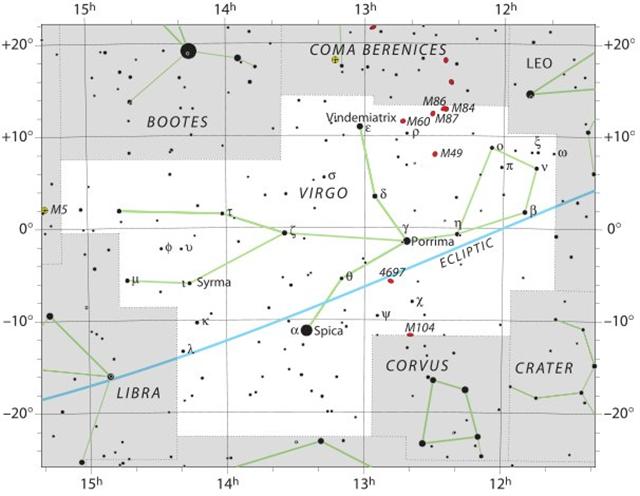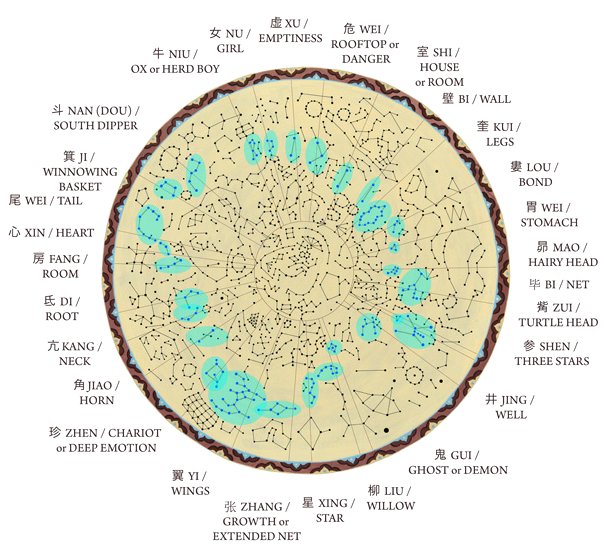306. According to Manuscript E there were 2 necklaces (one for each of 2 Hinariru figures) and there was a secret located in a verse and on a flat rock:
"Ira said, Let's go! Let's all go up to the dark abyss (i.e., the crater Rano Kau)! Nga Tavake replied, Let's go up there. They all went up to the yam plantation of Kuukuu. Once they had arrived there, Ira stayed for one month. Ira and all the others stayed there and cleaned up the yam plantation. They finished weeding the yam plantation. Another day dawned, and Ira said to Raparenga, Come here, you, so that I can teach you a verse (ki)! Raparenga came, and Ira taught him the verse. This is the verse he was taught:
There are eight lands. One has been discovered, namely, 'the little piece of earth' (te pito o te kainga). Seven (lands) (remain) in the midst of dim twilight during the fast journey (i te pei). Once lost (i.e., the eighth land), not even eight groups of people (i.e., countless boat crews) can find it again.
And Ira continued his speech:
Ruhi to the right, Pu to the left, and Hinariru in the middle, mother-of-pearl necklace around the neck of the figure Hinariru.
Raparenga said to Ira, Where is the figure of Hinariru? Ira replied to Raparenga, Up there, on top of that flat rock (papa), at the place where we rode the waves. Raparenga said to Ira, Let's return (there) to see (the figure)! Ira replied, Oh (no), let's leave it alone. When we ride the waves again, the wave will move quickly. If it moves to the right, the eye looks in the right direction and catches a glimpse of Ruhi Hepii. From there the ornament of Ruhi Hepii shines! Then one goes back out again, the wave moves to the left, the eye looks in the left direction, towards Pu. There the ornament of Pu shines forth! One repeats (riding the waves) toward the middle, the eye looks toward Papa O Rae. There the mother-of-pearl necklace of the figure Hinariru shines forth!"
So much is evident from the complex of events beginning when the Explorers went to the cave Pu Pakakina. The Explorers went to this cave in Hora Iti 29, which I have concluded should correspond to "August 29 at the time when the star Bharani would have been at 0h (80).
| JAN 30 |
31 (396) |
FEBR 1 |
2 (33) |
3 |
4 (*320) |
 |
 |
 |
 |
 |
 |
| Gb7-12 (193) |
Gb7-13 |
Gb7-14 |
Gb7-15 |
Gb7-16 |
Gb7-17 (427) |
| no star listed (14) |
1h (15.2)
β Phoenicis (15.1), υ Phoenicis, ι Tucanae (15.6), η Ceti, ζ Phoenicis (15.7) |
Al Batn Al Hūt-26 (Belly of the Fish) / Revati-28 (Prosperous) / 1-iku (Field Measure)
MIRACH (Girdle) = β Andromedae, KEUN MAN MUN (Camp's South Gate) = φ Andromedae (16.0), ANUNITUM = τ Piscium (16.5), REVATI (Abundant) = ζ Piscium (16.9)
REGULUS (α Leonis)
|
ν Phoenicis (17.4), κ Tucanae (17.6) |
no star listed (18) |
ADHIL (Garment's Train) = ξ Andromedae (19.3), θ Ceti (19.7) |
| April 4 |
5 (460 = 396 + 64) |
6 |
7 |
8 (*383) |
9 (99) |
| °March 31 |
°April 1 (91) |
2 (*377) |
3 |
4 |
5 (460) |
| 'March 8 |
9 |
10 |
11 (*355) |
12 |
13 (72) |
| "Febr 22 (53) |
TERMINALIA |
24 (420) |
Tehetu'upú 25 |
26 |
27 (*343) |
| CLOSE TO THE FULL MOON: |
| AUG 1 |
(214 = 31 + 183) |
3 (*135) |
4 (*501) |
5 |
6 |
| 13h (197.8)
ξ¹ Centauri (197.1), ξ² Centauri (197.9) |
APAMI-ATSA (Child of Waters) = θ Virginis, ψ Hydrae (198.5), DIADEM = α Com. Ber. (198.9) |
AL DAFĪRAH (Tuft) = β Com. Ber. (199.4) |
σ Virginis (200.4) |
γ Hydrae (201.0), ι Centauri (201.4) |
Al Simāk-12 (Lofty) / Chitra-14 (Bright One) / Horn-1 (Crocodile) / Sa-Sha-Shirū-20 (Virgin's Girdle) / ANA-ROTO-3 (Middle pillar)
MIZAR (Girdle) = ζ Ursae Majoris (202.4), SPICA = α Virginis, ALCOR = 80 Ursae Majoris (202.7)
SADALMELIK (α Aquarii)
*161 = *202.4 - 41.4 |
| Oct 4 (277) |
5 |
6 |
7 (*200) |
8 |
9 |
| °Sept 30 (273) |
°Oct 1 |
2 |
3 (*196) |
4 |
5 |
| 'Sept 7 (250) |
8 |
9 |
10 (*173) |
11 |
12 |
| "Aug 24 (236) |
25 |
26 |
27 |
28 |
29 (*161) |
 |
 |
 |
 |
 |
 |
| Ga5-23 |
Ga5-24 |
Ga5-25 (135) |
Ga5-26 |
Ga5-27 (→ 364) |
Ga5-28 |
|
Ahu. 1. Funerary monument with niches holding the skeletons of the dead. 2. Generic term for a grave, a tomb merely enclosed with stones. 3. Stone platform, with or without graves. 4. Elevated seat, throne. 5. Swollen; to swell up: ku-ahu-á tooku va'e, my foot is swollen; ananake te raá e-tagi-era te ûka riva mo toona matu'a ka-ahu ahu-ró te mata, every day the daughter cried for her parents until her eyes were quite swollen. Vanaga.
1. To transfer, to transplant, to take up by the roots. 2. To puff up, to swell, a swelling, protuberance; gutu ahu, swollen lips; ahuahu, to swell, plump, elephantiasis, dropsy; ahuahu pupuhi, amplitude; manava ahuahu, indigestion. 3. Paralysis. 4. A carved god of dancing, brought forth only on rare occasions and held of great potency. Ahuahu, inflammation. Ahukarukaru (ahu 2 - karukaru), dropsy. Churchill. |
Hora Iti 26
Ahu Akapu
(2 days) |
Aka. 1. Anchor: he-hoa te aka, to drop anchor. 2. Root of certain plants (banana tree, taro, sugar-cane). 3. To be paralyzed by surprise. Vanaga.
1. Root; aka totoro, to take root. P Pau., Mq.: aka, root. Ta.: aa, id. 2. (āka) anchor. 3. Causative (haka). Churchill. |
Hora Iti 29
Pu Pakakina
(1 month)
|
|
On the twenty-sixth day of the month of August ('Hora Iti') they went from Papa O Pea to Ahu Akapu. They all went and reached Ahu Akapu. They looked around and gave the name 'Ahu Akapu A Hau Maka'. They also saw (all of) Te Pito O Te Kainga, looked around, and gave (the whole island) the name 'Te Pito O Te Kainga A Hau Maka'. [E:31] They made camp and rested at Ahu Akapu for two days.
.jpg)
On the twenty-ninth day of the month of August ('Hora Iti') they went to Pu Pakakina. They arrived, remained there, and gave the name 'Pu Pakakina A Ira'. They remained one month in Pu Pakakina. |
It is stated [E:46] that in Hora Nui 1 the Explorers went up to the yam plantation of Kuukuu. Possibly the time in a cave did not count and possibly there was a dark (not to be counted) month beginning in day 161 from 0h, because day 161 counted from the beginning of the year had been where the month of the oak-king was beginning - and Hora Nui 1 (244) should be only 3 days after Hora Iti 29 (241).
... Midsummer is the flowering season of the oak, which is the tree of endurance and triumph, and like the ash is said to 'court the lightning flash'. Its roots are believed to extend as deep underground as its branches rise in the air - Virgil mentions this - which makes it emblematic of a god whose law runs both in Heaven and in the Underworld ... The month, which takes its name from Juppiter the oak-god, begins on June 10th and ends of July 7th. Midway comes St. John's Day, June 24th, the day on which the oak-king was sacrificially burned alive. The Celtic year was divided into two halves with the second half beginning in July, apparently after a seven-day wake, or funeral feast, in the oak-king's honour ...
However, the mysterious change from exact dates to the more sweeping 'one month' could be a hint of a change away from the Sun calendar and back to the order at the time when Bharani had been at 0h:
| |
Julian calendar |
pre-Julian |
|
| Martius (Tarahao) |
31 |
31 |
- |
| Aprilis (Vaitu Nui) |
30 |
29 |
+1 |
| Maius (Vaitu Potu) |
31 |
31 |
- |
| Iunius (He Maro) |
30 |
29 |
+1 |
| Quintilis (He Anakena) |
31 |
31 |
- |
| Sextilis (Hora Iti) |
31 |
29 |
+2 |
| Sum |
184 |
180 |
+4 |
| September (Hora Nui) |
30 |
29 |
+1 |
| October (Tangaroa Uri) |
31 |
31 |
- |
| Sum |
245 |
240 |
+5 |
| November (Ko Ruti) |
30 |
120 |
29 |
115 |
+1 |
| December (Ko Koró) |
31 |
29 |
+2 |
| Ianuarius (Tua Haro) |
31 |
29 |
+2 |
| Februarius (Tehetu'upú) |
28 |
28 |
- |
| Sum |
365 |
355 |
+10 |
Therefore, in order to look for the middle of the month of Jupiter we should try to count 14 days (glyphs) ahead from Ga5-28 (138). And 138 + 14 = 152 (also the day number for June 1):
| AUG 7 (219) |
8 (*140) |
9 |
10 |
11 |
12 (224) |
13 (*145) |
 |
 |
 |
 |
 |
 |
 |
| Ga5-29 |
Ga5-30 |
Ga6-1 |
Ga6-2 |
Ga6-3 |
Ga6-4 |
Ga6-5 (145) |
| 71 VIRGINIS (203.6) |
no star listed (204) |
HEZE = ζ Virginis (205.0), Southern Pinwheel Galaxy = M83 Hydrae (205.7) |
ε Centauri (206.3), κ Oct. (206.4) |
no star listed (207) |
τ Bootis (208.2), BENETNASH = η Ursae Majoris (208.5), ν Centauri (208.7), μ Centauri, υ Bootis (208.8) |
no star listed (209) |
| Oct 10 |
11 (284) |
12 (285) |
13 |
14 |
15 (*208) |
16 |
| °Oct 6 |
7 (280) |
8 |
9 |
10 |
11 (*204) |
12 (285) |
| 'Sept 13 (256) |
14 (*177) |
15 |
16 |
17 (260) |
18 |
19 (*182) |
| "Aug 30 (242) |
31 (284 - 41) |
"Sept 1 (*164) |
2 |
3 |
4 |
5 (*168) |
| Hora Nui 1 (238) |
2 (284 - 45) |
3 (*164) |
4 |
5 (242 = 260 - 18) |
6 |
7 (225 + 19) |
|
CLOSE TO THE FULL MOON: |
| FEBR 6 (*322) |
7 (403) |
8 (*324) |
9 (40) |
10 |
11 |
12 (408) |
| δ Phoenicis (21.5) |
υ Andromedae (22.9) |
ACHERNAR = α Eridani (23.3), χ Andromedae (23.6), τ Andromedae (23.9) |
ALSEIPH = φ Persei (24.5), τ Ceti (24.7) |
no star listed (25) |
ANA-NIA-10 (Pillar-to-fish by) χ Ceti (26.1), POLARIS = α Ursae Minoris, BATEN KAITOS = ζ Ceti (26.6), METALLAH = α Trianguli (26.9) |
Al Sharatain-1 (Pair of Signs) / Ashvini-1 (Horse's Head) / Bond-16 / Mahrū-sha-rishu-ku-1 (Front of the Head of Ku) SEGIN = ε Cassiopeia, MESARTHIM = γ Arietis, ψ Phoenicis (27.2), SHERATAN = β Arietis, φ Phoenicis (27.4) |
| April 11 (101) |
12 (*387) |
4-13 |
April 14 |
15 |
16 (471) |
17 (107) |
| °April 7 (97) |
8 (*383) |
9 |
10 (100) |
11 |
12 (*22) |
13 |
| 'March 15 (74) |
16 (*360) |
17 |
18 |
19 (78) |
20 (*364) |
0h |
| "March 1 (60) |
2 (*346) |
3 |
4 |
5 (64) |
6 (*350) |
7 |
| Tarahao 1 (58) |
2 (*163 + *183) |
3 |
4 |
5 (64 - 2) |
6 (*350) |
(64 = 29 + 28 + 7) |
En passent we should notice that the day numbers for the distance from April 25 (115) to June 1 (152) = 37 days, as a measure for the length of the sea voyage of the Explorers, will change to a more pleasing 36 (= 360 / 10) days = He Maro 1 (149) - Vaitu Nui 25 (113), a sign which supports my new interpretation of the dates in Manuscript E.
| AUG 14 |
15 |
16 (*148) |
17 (229) |
18 |
19 |
 |
 |
 |
 |
 |
 |
| Ga6-6 |
Ga6-7 |
Ga6-8 |
Ga6-9 |
Ga6-10 (151) |
Ga6-11 |
| MUPHRID = η Bootis (210.1), ζ Centauri (210.3) |
φ Centauri (211.0), υ¹ Centauri (211.1), υ² Centauri (211.8), τ Virginis (211.9) |
AGENA = β Centauri (212.1), θ Apodis (212.5), THUBAN = α Draconis (212.8) |
14h (213.1) π Hydrae, χ Centauri (213.0), MENKENT = θ Centauri (213.1) |
Neck-2 (Dragon) ASELLUS TERTIUS = κ Bootis, κ Virginis, 14 Bootis (214.8) |
Al Ghafr-13 (Covering) / Svāti-15 (Very Good) / TAHUA-TAATA-METUA-TE-TUPU-MAVAE-6 (a pillar to stand by) 15 Bootis (215.2), ARCTURUS = α Bootis (215.4), ASELLUS SECUNDUS = ι Bootis (215.5), SYRMA = ι Virginis, λ Bootis (215.6), η Apodis (215.8) |
| Oct 17 (290) |
18 |
19 |
20 |
21 (*214) |
22 |
| °Oct 13 |
14 |
15 (*208) |
16 |
17 (290) |
18 |
| 'Sept 20 |
21 |
EQUINOX |
23 (*186) |
24 |
25 (268) |
| "Sept 6 |
7 |
8 |
9 (*172) |
10 |
11 (254) |
|
Hora Nui 8 (245) |
9 |
10 |
11 (*172) |
12 |
13 (250) |
|
CLOSE TO THE FULL MOON: |
| FEBR 13 |
2-14 (45) |
15 |
16 (*332) |
17 (413) |
18 |
| ι Arietis (28.0), λ Arietis (28.2), υ Ceti (28.8) |
ALRISHA = α Piscium, χ Phoenicis (29.2), ALAMAK = γ Andromedae (29.7) |
Arku-sha-rishu-ku-2 (Back of the Head of Ku) 2h (30.4)
κ Arietis (30.3), HAMAL = α Arietis (30.5)
ALKES (α Crateris)
|
η Arietis (31.9) |
ξ¹ Ceti (32.1) |
χ Persei (33.2), θ Arietis (33.3), MIRA = ο Ceti (33.7) |
| April 18 (473) |
19 |
20 (*395) |
21 (111) |
22 |
23 |
| 4-14 |
°April 15 |
16 (471) |
17 (107) |
18 |
19 |
| 'March 22 |
23 |
24 (*368) |
EQUINOX |
26 (85) |
27 |
| "March 8 (67) |
9 |
10 (*354) |
11 |
12 |
13 (72 = 360 / 5) |
|
Tarahao 8 (65) |
9 |
10 (*354) |
11 |
12 |
13 (70 = 350 / 5) |
Significantly this was the place of Arcturus and with Mira at the Full Moon. From Leo to Bootes there were no bright constellations up above:

| AUG 20 |
21 |
22 |
23 (235) |
24 (*156) |
 |
 |
 |
 |
 |
| Ga6-12 (152) |
Ga6-13 |
Ga6-14 |
Ga6-15 |
Ga6-16 (156 = 12 * 13) |
| ι Lupi, 18 Bootis (216.3), KHAMBALIA = λ Virginis (216.4), υ Virginis (216.5), ψ Centauri (216.6), ε Apodis (216.8) |
ASELLUS PRIMUS = θ Bootis (217.8) |
τ Lupi, δ Oct. (218.1), φ Virginis (218.7) FOMALHAUT (α Piscis Austrini)
|
σ Lupi (219.1), ρ Bootis (219.5), HARIS = γ Bootis (219.7) |
σ Bootis (220.2), η Centauri (220.4) |
| Oct 23 (*216) |
24 |
25 |
26 |
27 (300) |
| °Oct 19 |
20 |
21 (*214) |
22 (295) |
23 |
| 'Sept 26 |
27 |
28 |
29 (*192) |
30 (273 = 3 * 91) |
| "Sept 12 |
13 |
14 (*177) |
15 |
16 (259) |
| Hora Nui 14 |
15 |
16 (*177) |
17 |
18 (255) |
|
CLOSE TO THE FULL MOON: |
| FEBR 19 |
20 (*336) |
21 (52) |
22 (418) |
TERMINALIA |
| no star listed (34) |
ξ Arietis (35.0), ρ Ceti (35.4), ξ² Ceti (35.9) |
σ Ceti (36.9) |
ν Ceti (37.9) |
ν Arietis (38.5), δ, ε Ceti (38.8) |
| April 24 (114) |
25 (*35) |
26 |
27 |
28 (*403) |
| °April 20 |
21 (*31) |
22 |
23 |
24 (*399) |
| 'March 28 |
29 (*8) |
30 |
31 (*375) |
'April 1 (91 = 7 * 13) |
| 3-14 (73) |
"March 15 |
16 (*360) |
17 |
18 |
|
Tarahao 14 (71) |
15 |
16 (*360) |
17 |
18 |
Possibly the necks of the pair of Hinariru figures, around which strings of mother-of-pearl were put, was inspired by the name of the 2nd Chinese station Neck:

Allen:
"ι, κ, and υ constituted the 13th sieu, Kang, a Man's Neck, κ being the determining star; while, with the preceding station, the united group was Sheu sing, as Edkin writes it, the Star of Old Age; and with others near, it may have been included in the Tien Mun [Heaven's Gate] mentioned at the star η."

|




.jpg)











